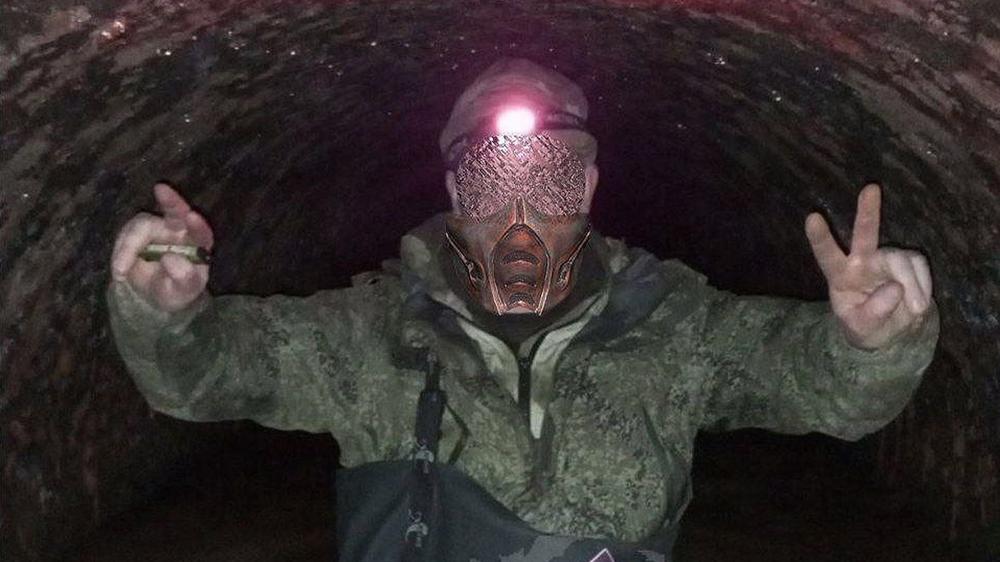A recent Russian assault in the embattled city of Kupiansk has once again thrust an uncommon, but often highly-effective tactic into the spotlight — using underground pipes to penetrate Ukrainian defensive lines
Russian units attempting to move across the Oskil River used a gas pipeline, monitoring group DeepState reported on Sept. 12, with soldiers using specially designed wheeled benches and electric scooters to maneuver.
They reportedly reached the nearby village of Radkivka "without serious losses" before moving to a forest and dispersing into Kupiansk.
But the tactic also has a huge cost for Moscow's forces — Russian independent media outlet Astra in July published a video of a soldier describing the chaos inside a pipe in Russia's Kursk Oblast where Ukrainian forces launched an incursion in 2024.
The man, later identified as Igor Garus from St. Petersburg, claimed that "dozens of soldiers suffocated, committed suicide, or died in panic and delirium."
"People were going crazy there. One shot himself. One… pointed a machine gun at himself. The second one smashed his head in," Garus says in the video.
"The Russians themselves call these tactical, pipe-based actions 'deadly attacks,' but they still accept the cost," Serhii Bratchuk, spokesperson for the Ukrainian Defense Army's Southern Division, told the Kyiv Independent.
"This is now an accepted tactic for Russia, and they use it."
The pipe in Kupiansk
Ukraine's General Staff confirmed on Sept. 13 that Russian forces had used a pipe to enter Kupiansk, but played down the success of the operation.
"The exit from the pipeline… is under the control of Ukrainian defenders," the military said. "The pipeline does not lead directly to the city."
Ukrainian Army Commander Yuriy Fedorenko told Radio Free Europe/Radio Liberty that Kyiv's forces flooded the pipeline to block the maneuver. "As a result, the pipe is now blocked," he said on Sept 17.
Ukrainian units were also clearing saboteurs who entered the city, while maintaining control of its center, he added.
A tactic with history
The use of underground passages in warfare is centuries old. Armies have long relied on tunnels to bypass defenses or move undetected.
During World War I, militaries dug networks beneath enemy trenches to plant explosives, while in the Vietnam War, U.S. forces faced the vast Cu Chi tunnel system used by the Viet Cong.
Russia has adopted the method, using decommissioned gas pipelines to bypass Ukrainian defenses and the threats posed by modern warfare.
The aim is to avoid detection by drones, artillery, and other strike systems, according to retired Ukrainian officer and defense expert Viktor Kevliuk.
"That is not some special tactic — it's just a way to get to the needed location safely," Kevliuk told the Kyiv Independent. "If there were a subway there, the enemy would move through that."
"If someone can move the required resources from point A to point B, then any method that achieves that should be considered effective."
First use in Avdiivka
The first notable case was in January 2024, during the battles for Avdiivka, Donetsk Oblast. Russian troops discovered a long section of an abandoned underground pipeline and used it to infiltrate a fortified Ukrainian position.
Russian lawmaker Eduard Sharafiyev, who fought in Ukraine, told Russian media in 2024 that the pipe had been identified as early as February 2023.
During preparations for the assault, Ukrainian forces discovered Russian troops gathering at an entry point and struck them with artillery, he said.
After weeks of preparation, Russian troops tried again. This time, they traveled more than two kilometers underground, emerging behind Ukraine's lines, and managing to capture part of the fortified area.
"This tactic, unfortunately, proved its worth during the battles around Avdiivka," Bratchuk said.
Sudzha operation
Russia revived the tactic in 2025 during its counteroffensive in Kursk Oblast.
Ukrainian forces had launched a cross-border incursion in August 2024, seizing around 1,300 square kilometers (500 square miles) of territory.
By spring 2025, Russian troops began pushing back.
"Senior Russian officers have never valued a soldier's life highly."
In Sudzha, located less than 10 kilometers (6 miles) from Ukraine's border, Russian soldiers moved through a decommissioned gas pipeline for 12–15 kilometers (7–9 miles), emerging behind Ukrainian lines.
According to Russia's Chief of the General Staff Valery Gerasimov, over 600 soldiers took part in the operation.
Russian troops spent four days inside the pipe before launching an assault that Moscow claimed secured several villages.
"Regarding Sudzha or Avdiivka, it should be understood that it's impossible to move a large number of troops through a pipe," Kevliuk said.
"The main factor for the enemy's success is surprise — acting unexpectedly in the rear of our forces."
Ukraine's General Staff confirmed that Russia tried to use the pipeline but claimed its forces identified the groups and inflicted heavy losses with drones and artillery.
High cost for Russian soldiers
Russian troops have not only suffered casualties in battle but also inside the pipelines themselves.
"Everyone who was in the tunnel (to reach Sudzha) suffered lung damage," Russian propagandist and war blogger Anastasia Kashevarova said in June.
"The fighters were suffocating. Some had already died."
Bratchuk emphasized the dangers posed by even decommissioned pipelines, pointing out the serious health risks for any Russian soldier sent inside.
"Many develop chronic illnesses that are untreatable; a lot become disabled or die," he said.
"Senior Russian officers have never valued a soldier's life highly — sending hundreds of fighters into such conditions is not difficult for them."
Ukraine's countermeasures
Experts say Ukraine must develop systematic defenses against such tactics used by Moscow.
"It's obvious these methods can be used in other locations," Bratchuk said. "Therefore, the response must be official and systematic."
"The quickest responses are to blow up pipes or flood them. What would be more effective is coordinated work with local authorities and specialists who understand the pipes, sewage, and gas systems."
Bratchuk also highlighted the difficulty of tracking the underground pipeline network on Ukrainian territory, saying that many of the original plans remain in Russia.
"We have problems mapping this network… The system was designed and built in the Soviet era, and we lack a lot of that information," he said.
One of the other measures Ukrainian forces use to counter the pipeline tactic is filling the tunnels with barbed wire, Ivan Stupak, a government adviser who used to serve with the Security Service of Ukraine (SBU), said.
"There are photos online of Russians trying to crawl into these pipes. Ukrainians packed them with a lot of barbed wire," he told Radio NV.
"And not like that used in World War I, but really sharp wire. If you get tangled in it, it's almost impossible to get out on your own."
Kevliuk said the simplest response is to keep pipeline exits under fire control, while a more complex approach is to demolish a section near the entrance.
"Overall conclusion — if you're organizing the defense, study the terrain and the engineering networks thoroughly in your area of responsibility," he said.
Note from the author:
Hi, this is Tim. The author of this article. Thank you for taking the time to read it. At the Kyiv Independent, we speak to top experts to bring you accurate, in-depth reporting. We don't have a wealthy owner or political backing. We rely on readers like you to support our work.

 I miniLED si mangiano le quote di mercato dell'OLED a vantaggio di TCL, Hisense e Xiaomi
I miniLED si mangiano le quote di mercato dell'OLED a vantaggio di TCL, Hisense e Xiaomi